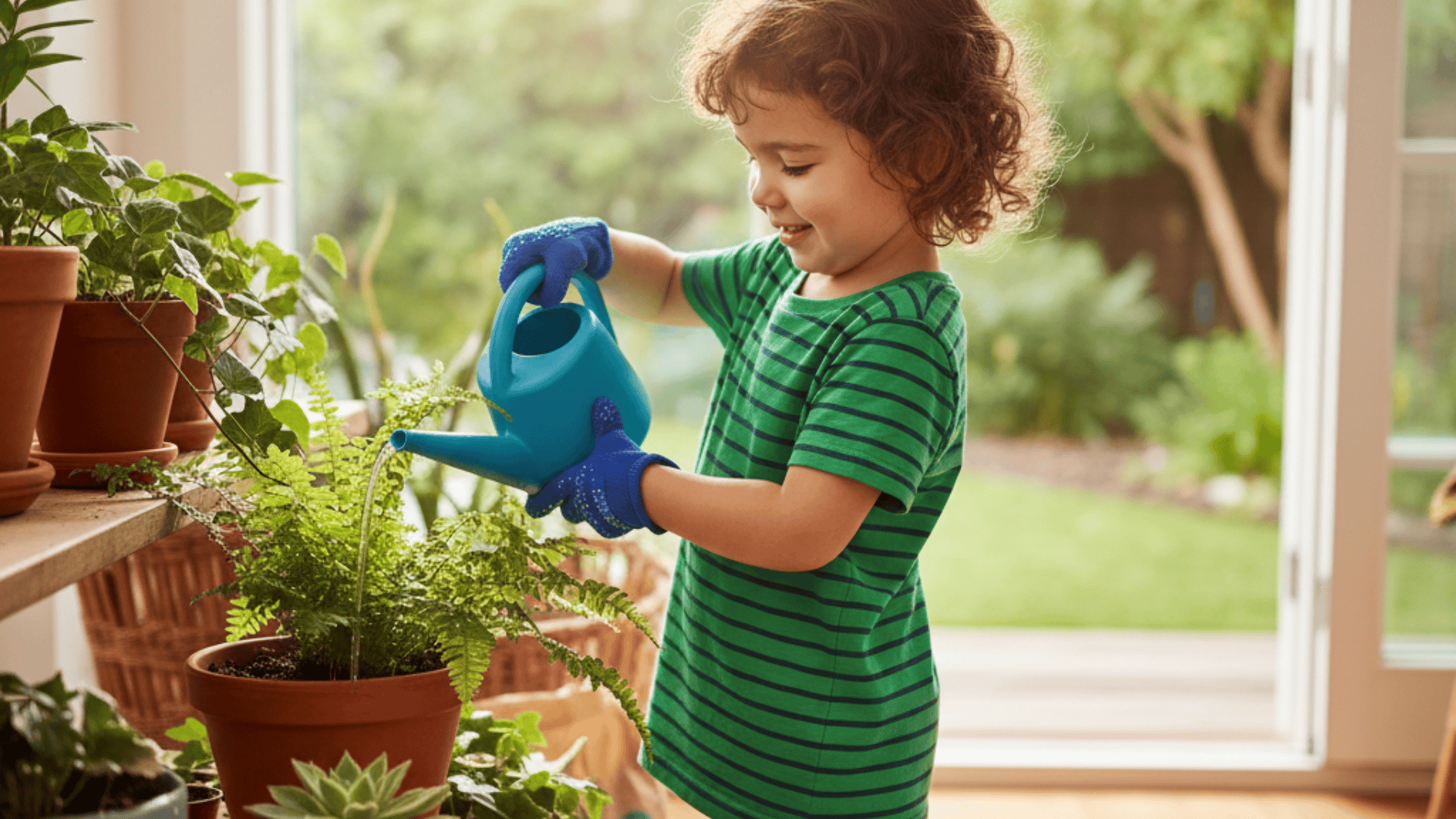Natural activities are all about interacting directly with the environment. Children can observe plants and animals, search outdoor spaces, and use their senses to learn about the natural world.
These activities help kids connect with the outdoors while developing physical, mental, and emotional skills.
It encourages creativity, imagination, and sensory understanding using leaves, rocks, soil, and other natural materials.
Find a wide variety of ideas, from quick-start, low-prep games to creative projects like fairy gardens, sensory bins, and STEM-based outdoor experiments, along with safety tips to make every outdoor moment fun, inclusive, and educational.
Why Nature Activities for Kids are Important
Kids learn best when movement meets discovery. Nature activities turn outdoor play into hands-on lessons about the world around them.
- Balance screen time with outdoor exploration
- Boost strength, coordination, and immune health
- Reduce stress and improve focus naturally
- Encourage imagination through real-world experiences
- Build teamwork, independence, and confidence outdoors
From climbing trees to exploring trails, every outdoor moment helps kids grow stronger – body, mind, and heart.
Must-Try Outside Activities for Kids
Spending time outdoors helps children grow physically, mentally, and emotionally. These activities encourage learning, movement, and imagination while keeping kids active in the fresh air.
Quick-Start Ideas (Low-Prep, Anytime)
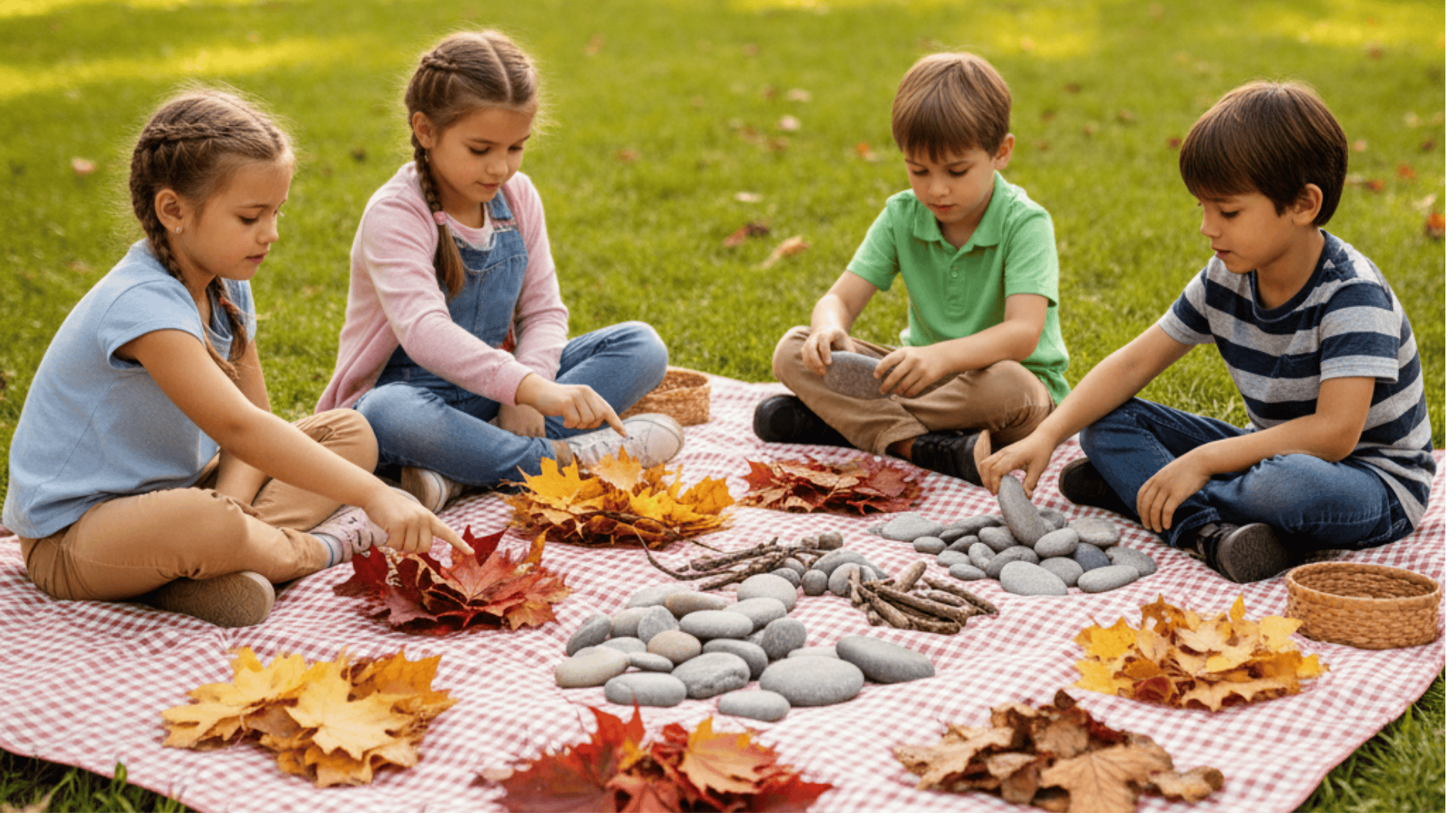
These simple activities need little preparation and can be done almost anywhere. They’re perfect for helping children connect with nature quickly.
1. Go on a Daily Nature Walk
Take your child on short walks around the neighborhood, local parks, or even the backyard. Ask them to notice shapes, colors, and sounds around them.
Encourage questions and observations. Walking builds healthy routines, increases focus, and sparks curiosity, while also creating moments to talk, learn, and share simple joys together.
2. Collect and Sort Leaves & Rocks
Ask children to gather leaves, twigs, or stones and sort them by size, shape, or color. They can also create patterns or arrange them into designs.
This activity improves classification skills, patience, and focus. It helps kids pay closer attention to natural details and find new ways to use everyday items creatively.
3. Play a Nature “I Spy” Game
Choose objects in nature and challenge your child with clues such as, “I spy something round” or “I spy something red.” They’ll enjoy searching for the answer while learning new words and improving focus.
The game mixes play with observation, making outdoor time fun, social, and stimulating for both younger and older children.
4. Create a Color Hunt
Give kids a list of colors and ask them to match each one with an item outdoors, like red leaves, yellow flowers, or brown twigs. Adding a timer can make the challenge more exciting.
This strengthens observation, attention, and artistic awareness, helping kids see how rich and varied the natural environment really is.
5. Listen to Nature Sounds and Identify Them
Spend time sitting quietly with your child and focus on sounds around you, such as birds, flowing water, or rustling leaves. Ask them to describe what they hear and guess the source.
This activity sharpens listening, concentration, and awareness, while helping children feel calm and more connected to outdoor surroundings.
6. Spot Shapes in Tree Bark or Stones
Encourage kids to look for patterns or letters in bark, rocks, or even clouds. They can sketch or describe what they see. This activity supports creativity, visual analysis, and imagination.
It helps children notice the hidden details in everyday objects and develop new ways of interpreting what they see in the natural world.
Nature Finding & Observation
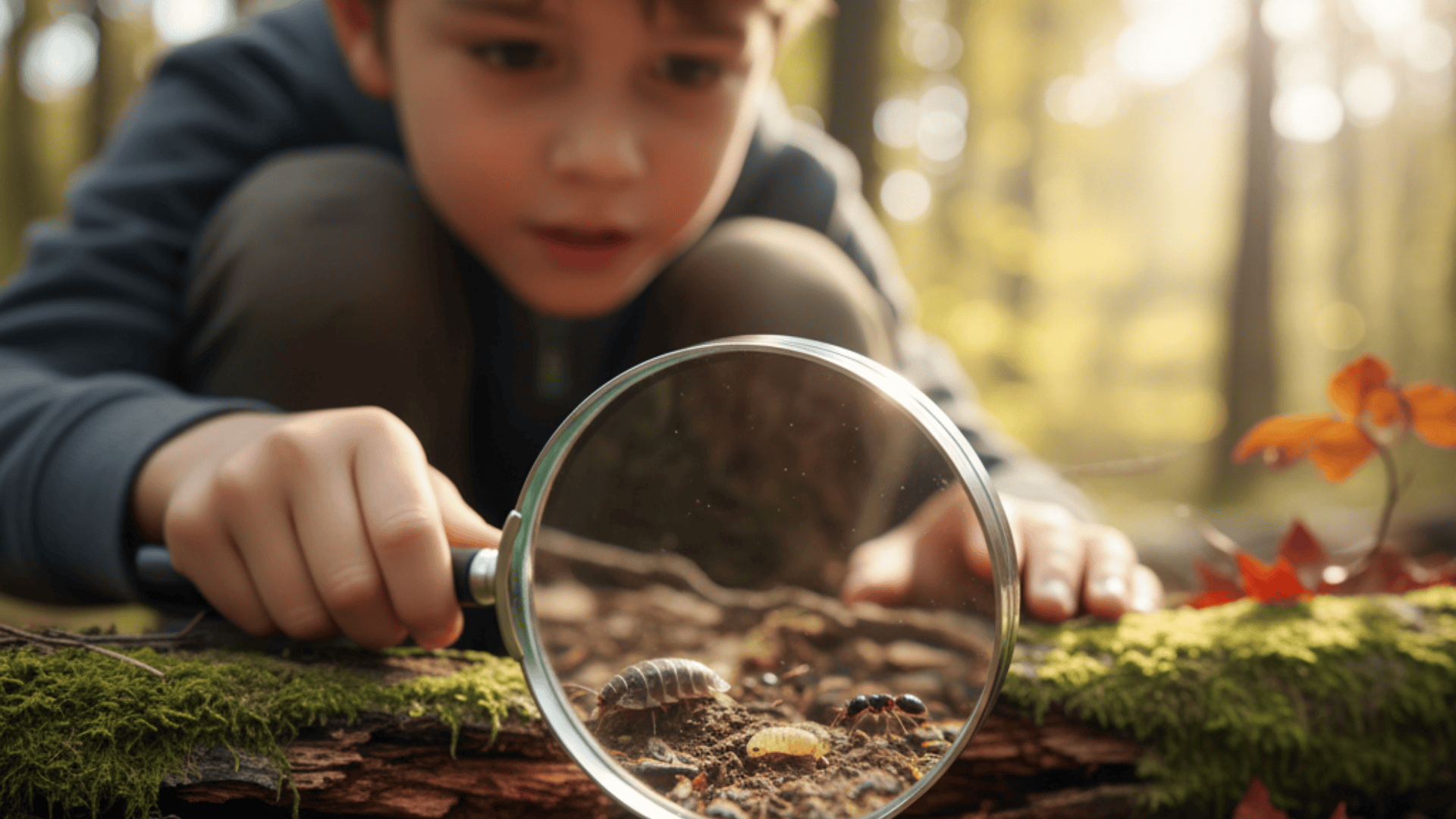
These activities encourage children to watch nature more carefully and build curiosity about how living things behave and interact.
7. Try a Nature Scavenger Hunt
Prepare a list of outdoor items like acorns, pinecones, or flowers. Give kids a checklist to complete as they search. This structured activity builds organization and focus while making outdoor time exciting.
Children learn to plan, problem-solve, and stay engaged, all while developing an appreciation for different natural materials they gather along the way.
8. Go on a Bug & Insect Hunt
Hand children a magnifying glass and guide them to look under logs, rocks, or leaves. They can note insects, record movement, and compare features.
This improves patience, observation, and respect for small creatures. It also introduces children to basic science concepts while encouraging gentle, responsible interaction with living organisms in their habitats.
9. Watch and Record Birds
Provide binoculars and a notebook for children to watch local birds. They can sketch, count, or record feeding habits. This teaches patience, accuracy, and the importance of data collection.
Observing birds helps children understand animal behavior and patterns, while sparking curiosity about ecosystems, migration, and the wildlife that shares their environment.
10. Study a Tree Through the Seasons
Choose one tree and return to it regularly over weeks or months. Encourage children to note changes in leaves, blossoms, or visitors like birds and insects.
Recording drawings or photos builds observation, patience, and awareness of natural cycles. It helps kids see how time affects growth and strengthens appreciation for long-term change in nature.
11. Look for Animal Tracks and Footprints
After rain, snow, or in sandy areas, look for footprints from dogs, birds, or wild animals. Ask children to compare size, shape, and patterns. They can record guesses about which animal made them.
This activity sharpens attention, critical thinking, and introduces kids to the ways animals move and interact with their environment.
12. Observe Ant Trails with a Magnifying Glass
Guide children to watch how ants move, communicate, and gather food. Noticing lines of ants and their teamwork builds focus and curiosity.
Kids learn about cooperation, problem-solving, and how even tiny insects play a role in larger ecosystems. Observing ants introduces simple biology concepts in a way that feels immediate and engaging.
13. Collect and Compare Different Seeds
Gather seeds from trees, flowers, or grasses and examine their shapes, colors, and textures. Children can sort and group them. This activity builds classification skills, attention to small details, and appreciation for plant diversity.
It also introduces the idea that seeds are beginnings, teaching children about growth and the potential hidden in nature.
14. Watch the Moon Phases Over a Month
Encourage children to look at the moon every night and note its shape in a journal. Over time, they’ll see the cycle from crescent to full.
This teaches patience, pattern recognition, and an early introduction to astronomy. Children learn about cycles of time while connecting natural changes to the larger universe.
15. Build a Nature Diary with Sketches
Provide a notebook where children can record walks, sketches, or pressed leaves. Writing or drawing builds memory, literacy, and creativity. A diary encourages reflection and makes children proud of their observations.
Over time, it becomes a personal record of growth, learning, and moments spent outside, which they can revisit and share with others.
Creative Nature Crafts & Play
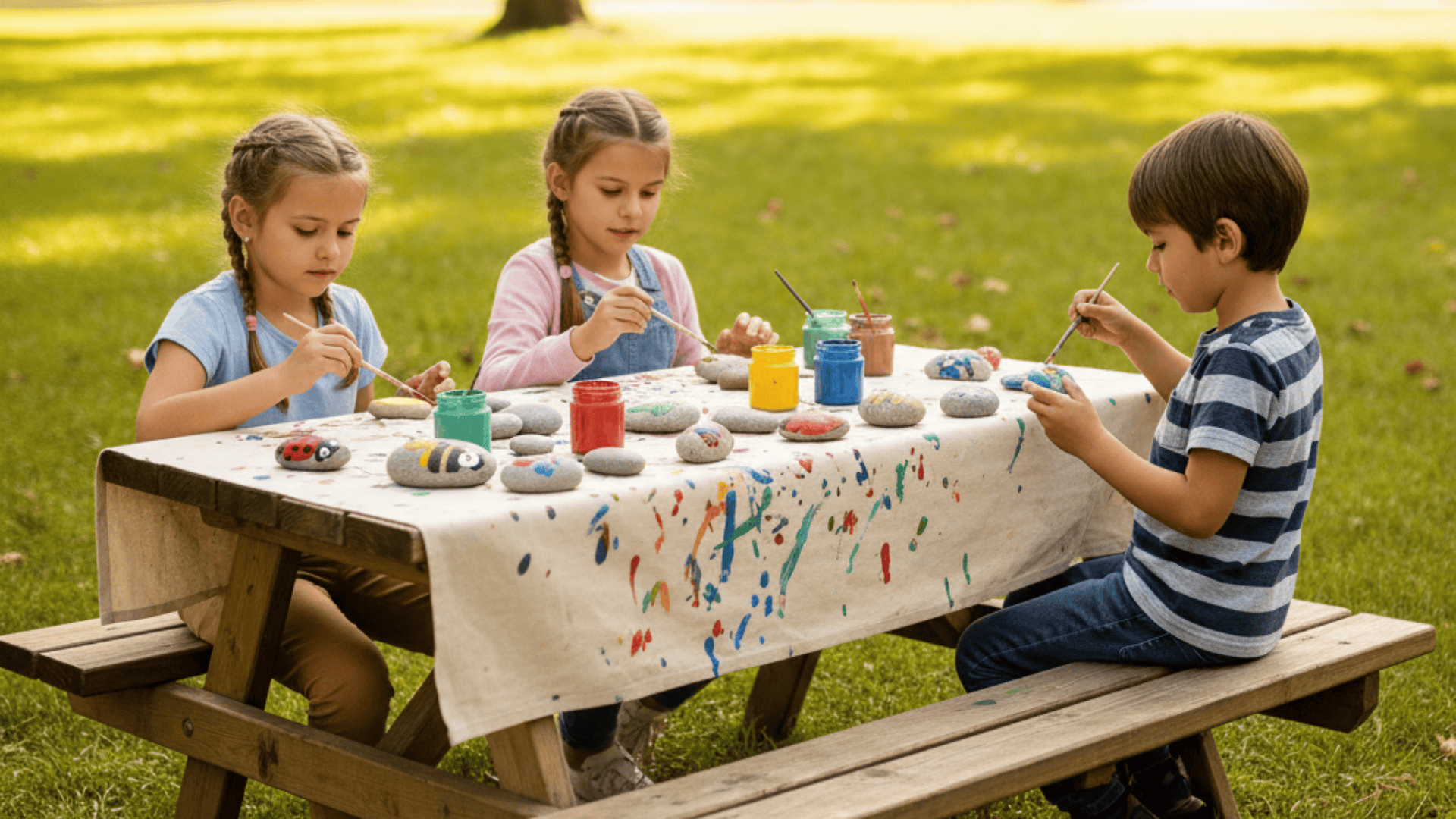
These activities combine outdoor materials with creativity. They let children make art, build objects, and use their imagination while spending time outside.
16. Make Leaf Rubbings with Crayons
Place a leaf under paper and rub a crayon gently over the top. The outline and patterns will appear clearly.
This activity teaches children about shapes and textures while also improving fine motor skills. It creates a fun piece of art that they can keep or display.
17. Paint and Decorate Rocks
Collect smooth rocks and use safe paints to create designs, animals, or colorful patterns. Rock painting encourages focus, planning, and artistic skills.
Finished pieces can be used for games, decorations, or gifts, turning a simple natural object into something creative and personal.
18. Create a Contact Paper Sun Catcher
Arrange petals, leaves, and small twigs between two sheets of clear contact paper. Hang it in a window where light can shine through.
This craft teaches kids about colors, shapes, and light while giving them a chance to design something beautiful from natural items.
19. Build Fairy Houses or Miniature Gardens
Use sticks, leaves, stones, and flowers to build small houses or gardens. Children can design their own little spaces, practicing creativity and problem-solving.
This activity connects imagination with nature and can also be done with friends for group play.
20. Set Up a Mud Kitchen for Pretend Play
Provide old pans, cups, and spoons for children to mix mud, sand, and water. They can make “meals” or experiment with textures.
This sensory play improves motor skills, encourages imagination, and lets kids enjoy hands-on fun outdoors in a safe way.
21. Make a Nature Collage or “Nature Letters”
Collect leaves, flowers, twigs, and seeds to form shapes, letters, or whole pictures on paper. This activity combines art with literacy by letting kids spell words or names.
It teaches creativity, coordination, and design skills while producing a unique piece of natural artwork.
22. Create Nature Crowns with Leaves & Flowers
Use flexible twigs, leaves, and flowers to create crowns that children can wear. Making crowns builds fine motor skills and design thinking while helping kids notice textures and patterns.
The crowns also give them something playful to use during outdoor playtime.
23. Make Stick and Leaf Puppets
Attach leaves or flowers to sticks and turn them into puppets. Children can act out stories or invent characters. Puppet play improves creativity, confidence, and communication skills.
It also gives kids a fun way to connect storytelling with natural materials.
24. Build a Simple Nature Loom for Weaving
Create a small frame with sticks or string and weave in grass, flowers, and leaves. Children practice patience, coordination, and pattern-making.
This activity introduces them to weaving in a simple way while letting them enjoy working with textures and colors.
25. Paint with Mud and Natural Pigments
Mix mud, soil, or crushed flowers to make paint. Children can use it on rocks, paper, or wood.
This sensory activity connects them to natural materials while encouraging creativity and hands-on experimentation. It’s simple, fun, and teaches kids how colors can come from nature.
Gardening & Outdoor Learning
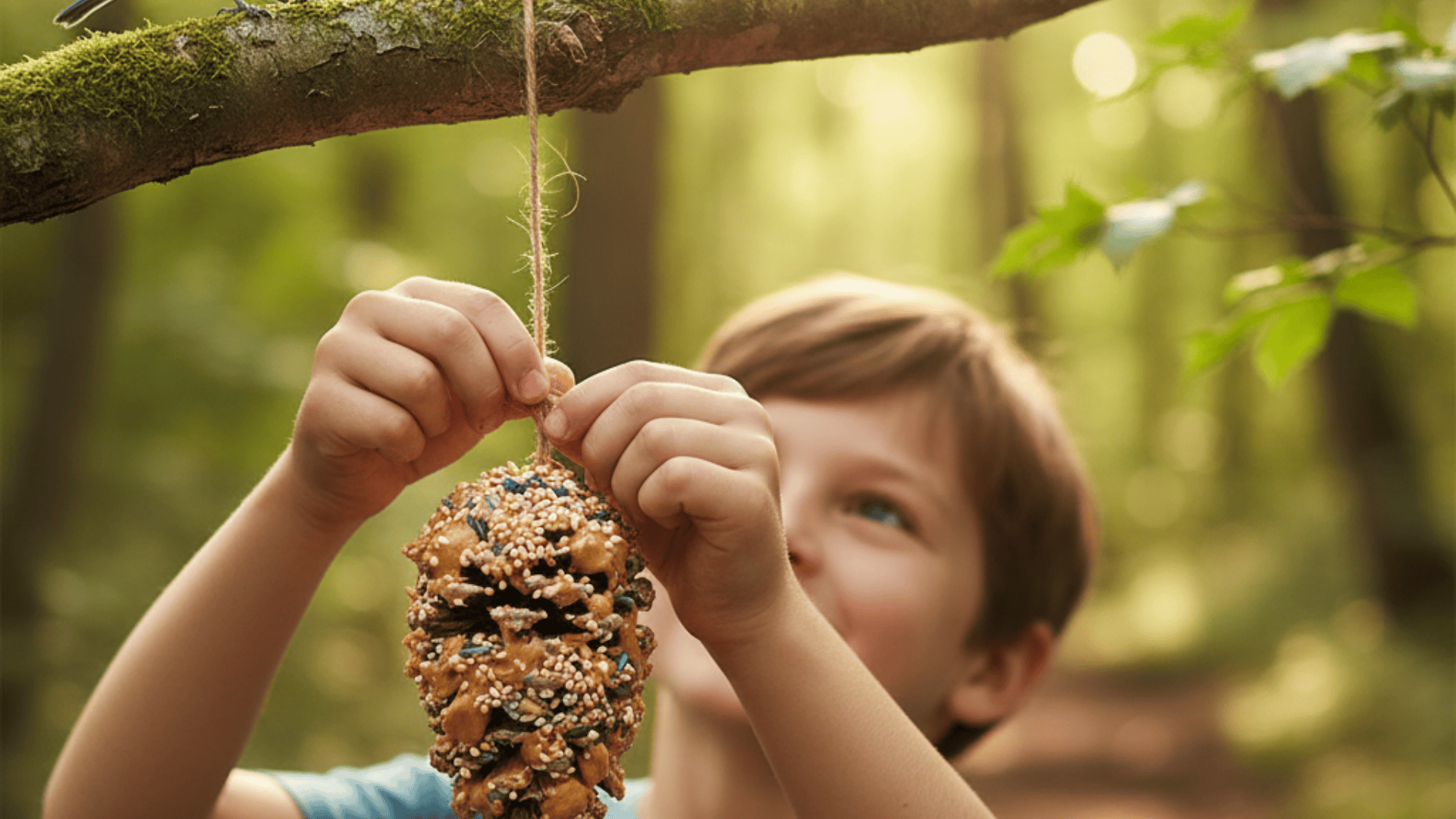
These activities combine science and care for living things. They teach children patience, responsibility, and respect for nature.
26. Plant Fast-Growing Seeds
Give kids seeds such as beans or sunflowers that sprout quickly. They can water them daily and track changes. This activity teaches patience, plant care, and the basics of life cycles.
Children also feel proud when they see plants growing because of their efforts.
27. Create a Mini Wildlife-Friendly Garden
Plant flowers or shrubs that attract birds, bees, or butterflies. Children can watch which animals visit and learn how plants support local wildlife.
This teaches ecosystem basics and helps kids see the value of caring for small outdoor spaces.
28. Build a Simple Bird Feeder
Use pinecones or small containers, coat them with peanut butter, and roll them in seeds. Hang them outside for birds to enjoy.
Children learn about bird feeding habits and observation while making something useful that supports local animals.
29. Make a Bee Hotel with Recycled Materials
Use bamboo, wood, or tubes to make a shelter for solitary bees. Children learn about pollinators, their importance, and how they help plants.
This activity teaches respect for insects and gives kids a way to directly support the environment.
30. Compost Food Scraps into Plant Fertilizer
Save vegetable peels, fruit scraps, and leaves to make compost. Children can observe how scraps break down into soil.
This teaches sustainability, recycling, and the value of reducing waste while helping plants grow healthier in gardens.
31. Grow Herbs in Pots and Taste Them
Plant herbs like mint, basil, or parsley in small pots. Children can water them, watch them grow, and try the flavors.
This builds responsibility, connects kids to healthy food, and teaches them how plants are part of everyday meals.
32. Learn How Worms Help Soil by Digging for Them
Guide children to look for worms in the soil and notice how they move. Explain how worms help keep soil healthy.
This activity builds curiosity, teaches simple science, and shows kids how even small creatures are important to the earth.
33. Grow a Plant from Kitchen Scraps
Use parts of vegetables like lettuce or potatoes to regrow new plants. Children can watch the process in soil or water.
This shows how food waste can create new growth, teaching patience, sustainability, and a sense of accomplishment.
34. Start a Mini Terrarium in a Jar
Fill a jar with soil, moss, small plants, and pebbles to create a mini ecosystem. Children can watch how water cycles inside the jar and how plants thrive.
This activity introduces kids to ecosystems while giving them a long-term project to maintain indoors.
Sensory & Messy Play
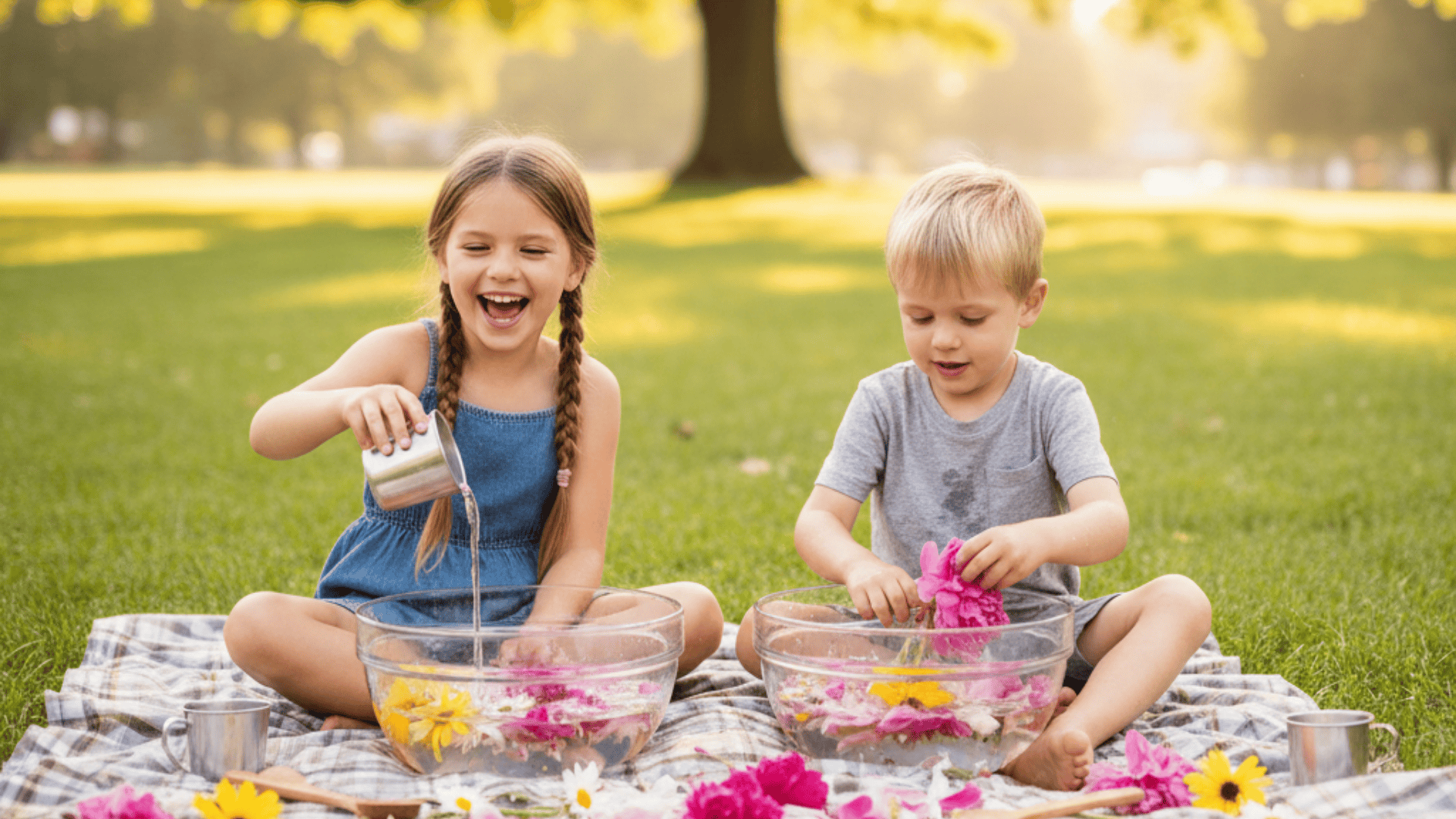
These activities let children use their senses while working with natural materials. They are fun, hands-on, and help kids build fine motor skills while staying active outdoors.
35. Make Mud Pies with Sticks & Leaves
Give kids mud, water, sticks, and leaves to create pretend pies or meals. This activity encourages imagination and hands-on learning.
It helps children understand textures, practice motor skills, and enjoy open-ended outdoor play that feels creative and fun.
36. Use a Nature Sensory Bin
Fill a container with items like sand, soil, leaves, or small stones. Children can scoop, sort, and touch the materials.
This activity improves focus, observation, and sensory awareness while giving kids the freedom to experiment safely with different textures.
37. Try Water Play with Flowers & Petals
Provide bowls of water and allow kids to float leaves, petals, or flowers. They can pour, mix, and move items around.
This activity supports creativity, fine motor skills, and sensory development, while offering a calming way to enjoy time outside.
38. Play Barefoot on Different Textures
Encourage children to walk, run, or jump barefoot on grass, sand, or soil. This simple activity strengthens balance, coordination, and foot muscles.
It also helps kids feel closer to nature and improves sensory awareness through direct touch.
39. Smell and Match Herbs or Flowers Blindfolded
Blindfold kids and let them identify herbs, leaves, or flowers by scent. This builds memory, attention, and curiosity.
The game is fun, safe, and helps children notice how plants differ in fragrance and character.
40. Build Sandcastles with Natural Decorations
Use sand, pebbles, shells, or twigs to create castles and decorate them. This activity develops planning skills, spatial awareness, and creativity.
It also allows children to work together while building and designing outdoor structures.
41. Freeze Leaves or Flowers in Ice Cubes and Play
Place leaves or petals in water, freeze them, and let kids handle the cubes. They can watch them melt, touch the textures, and talk about the changes.
This activity combines science, sensory play, and curiosity in a simple way.
IndoorNature Activities (Rainy Day Ideas)

These ideas keep kids engaged with nature even when they can’t go outside. They are creative, fun, and easy to set up indoors.
42. Keep a Nature Journal with Drawings & Notes
Give children a notebook to sketch plants, write about insects, or record weather changes. Journaling improves memory, drawing, and writing skills.
It also helps kids reflect on their experiences and build lasting connections with nature.
43. Organize an Indoor Scavenger Hunt
Hide natural items like rocks, leaves, or shells around the house. Give kids a list of things to find.
This activity teaches problem-solving, observation, and focus while keeping the excitement of outdoor play alive indoors.
44. Craft with Leaves, Rocks, and Flowers
Use collected natural items to make collages or small sculptures. This activity supports creativity, patience, and design skills.
Kids can reuse items they’ve found outdoors, giving them a fresh purpose while practicing art indoors.
45. Watch a Nature Documentary
Play videos of forests, oceans, or wildlife for children. They can learn about animals and ecosystems while staying indoors.
This encourages curiosity, scientific knowledge, and can inspire kids for future outdoor activities.
46. Create a Shadow Play with Leaves and Flashlights
Use leaves or twigs with a flashlight to cast shadows on the wall. Kids can create shapes and patterns or invent short stories.
This activity combines creativity, observation, and early science learning in a fun, playful way.
47. Make a Pressed-Flower Bookmark
Press leaves or flowers in books, then use them to create bookmarks. This activity teaches patience, care, and creativity.
It also helps children understand plant preservation while making something useful they can keep or gift.
48. Build a Nature Display Box or Shelf
Organize collected items like rocks, seeds, or shells in a small box or on a shelf. Children practice sorting, classifying, and design skills.
It also gives them a sense of pride in displaying their favorite nature finds.
49. Paint Pebbles and Use Them for Storytelling
Let children paint symbols, animals, or designs on small stones. They can later use these painted pebbles as storytelling prompts.
This activity combines art, creativity, and narrative skills, giving kids a fun way to connect imagination with natural objects.
Educational Spin (STEM Connections)
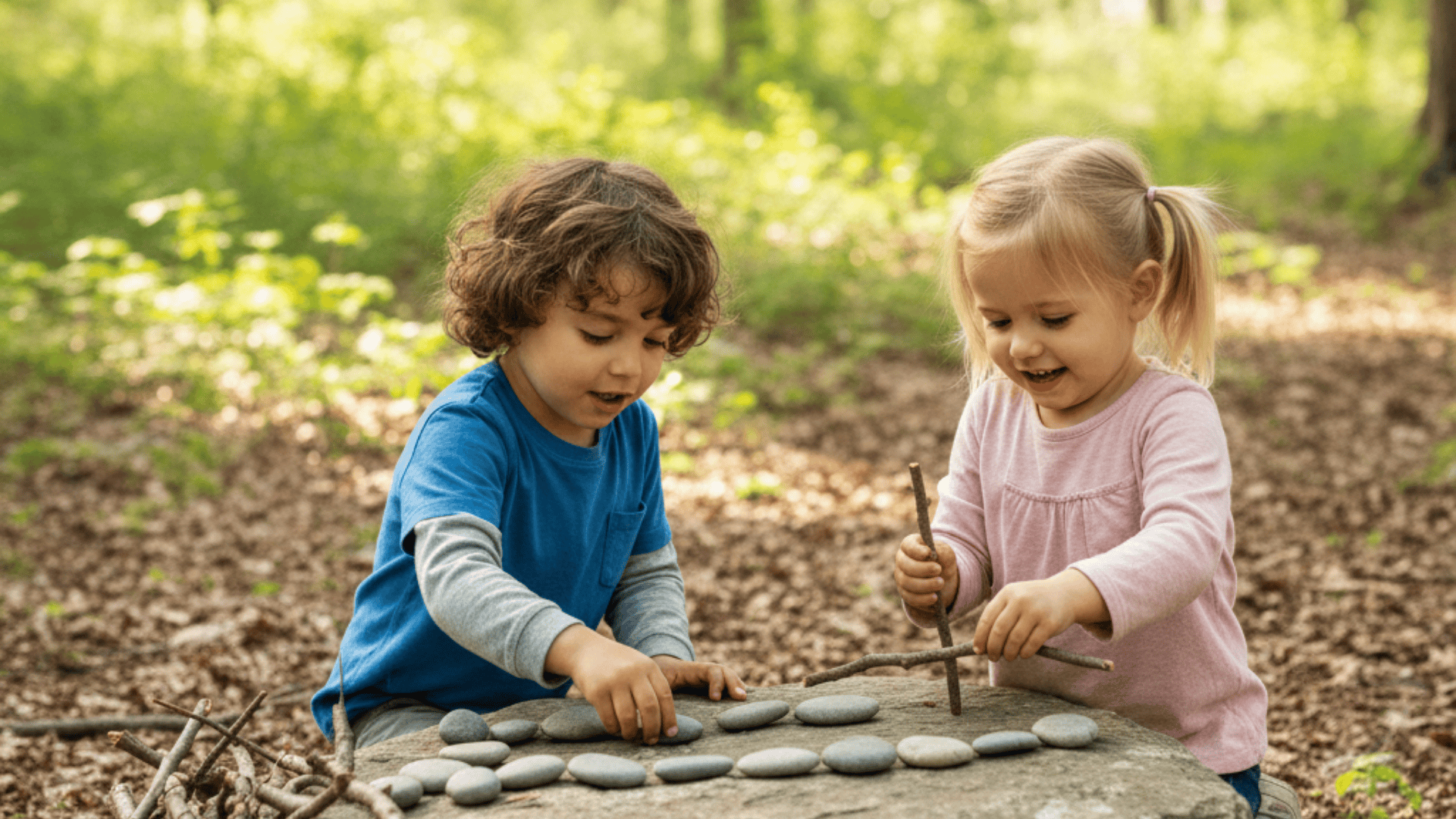
These activities combine science and outdoor play. They help children practice critical thinking, problem-solving, and hands-on learning.
50. Build a DIY Rain Gauge or Weather Station
Use a plastic bottle to make a simple rain gauge. Children can measure rainfall and record data over time.
This teaches observation, measurement, and weather basics in a hands-on way. It makes science easy to understand and fun to practice daily.
51. Practice Math Games with Rocks & Twigs
Use natural objects to count, sort, or create patterns. Children can practice addition, subtraction, or simple sequences.
This activity improves math skills while keeping it playful and interactive, turning outdoor items into learning tools.
52. Learn About Food Chains with Nature Cards
Create cards that represent plants, herbivores, and predators. Have children arrange them in order to show how energy moves in an ecosystem.
This activity helps kids understand relationships in nature and builds early science knowledge.
53. Record Observations Using the Scientific Method
Encourage children to ask a question, make a prediction, and record what happens in a simple experiment, like growing plants.
This builds reasoning, observation, and science skills. It also introduces them to structured ways of learning and testing ideas.
54. Compare Soil Samples from Different Places
Collect soil from the backyard, park, or garden. Children can compare color, texture, and moisture.
This activity teaches observation, analysis, and critical thinking, helping kids see differences in local environments.
55. Test How Different Leaves Float or Sink in Water
Place different leaves in water and watch which ones float or sink. Children can record and compare results.
This experiment encourages observation, attention to detail, and early science concepts while being easy and fun to try outdoors.
Seasonal Nature Activities

These activities help kids notice how nature changes throughout the year. They connect outdoor play with weather, plants, and wildlife.
56. Spring: Pick Flowers or Build a Bug Hotel
Let children gather fallen flowers or plant new ones. They can also build a bug hotel with sticks, leaves, and recycled items.
This teaches kids about pollination, insect homes, and seasonal changes while encouraging hands-on learning and creativity.
57. Summer: Go Stargazing or Try Backyard Camping
Set up a small tent outside for stargazing and family camping. Teach children about constellations and moon phases while enjoying the outdoors.
This activity builds curiosity, observation, and family bonding during warm nights.
58. Fall: Create Leaf Collages & Acorn Crafts
Collect fallen leaves and acorns to make collages or decorations. Children practice creativity, motor skills, and design thinking.
This activity also helps kids notice seasonal colors and textures while making something fun to display.
59. Winter: Make Pinecone Bird Feeders or Study Snow Prints
Use pinecones, seeds, and peanut butter to create bird feeders. Children can also look for tracks left in the snow by animals.
These activities teach observation, respect for wildlife, and ways to support animals in colder months.
Safety & Accessibility Tips
Spending time in nature is fun, but safety and accessibility are important. These tips help children enjoy outdoor activities while staying safe and comfortable:
- Check plants and insects: Inspect the area for harmful plants or bugs. Teach children what to avoid and supervise closely.
- Use protective gear: Gloves, hats, and closed shoes protect against scratches, bites, and sun exposure.
- Modify for all abilities: Adapt activities with tools, adjustments, or indoor alternatives so every child can join in.
- Sun protection: Apply sunscreen, wear hats, and take breaks in shaded spots on hot days.
- Stay hydrated: Keep water close and encourage frequent sips to prevent dehydration.
Following these tips ensures outdoor activities remain fun, safe, and inclusive for all children while helping them enjoy and connect with nature.
Conclusion
Nature activities for kids provide endless opportunities for understanding, learning, and creative play.
By spending time outdoors, children develop observation, problem-solving, and sensory skills while connecting with the natural world.
Incorporating simple games, DIY experiments, or seasonal projects keeps outdoor time exciting, engaging, and educational.
Following safety and accessibility tips ensures every child can participate comfortably, increasing confidence and curiosity.
Making these activities part of daily routines promotes a lifelong appreciation for nature and healthy, active habits.

